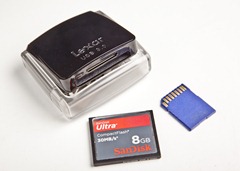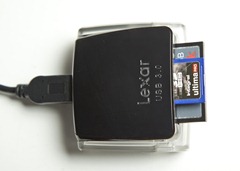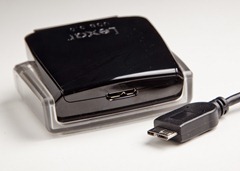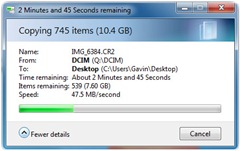Lexar USB 3 Card Reader ~ Review
 Hopefully every photographer reading this already knows that the best and fastest way to get your images from a memory card to your computer is via a card reader. For the past few years I’ve been using either the internal card reader fitted to my PC or an external Compact Flash card reader. Both have been great, but all of a sudden they’re out of date!
Hopefully every photographer reading this already knows that the best and fastest way to get your images from a memory card to your computer is via a card reader. For the past few years I’ve been using either the internal card reader fitted to my PC or an external Compact Flash card reader. Both have been great, but all of a sudden they’re out of date!
So what’s changed? Well my new PC is fitted with the a couple of USB 3 sockets and on paper USB 3 is up to 10 times faster then USB 2 which powers my existing card readers. Now the important words in that last sentence were “on paper" and “up to” because as the saying goes… results may vary.
I really wanted to test the speed claims for USB 3 so I bought a Lexar USB 3 card reader, but before I get to the speed test, lets take a closer look at what I bought.
 Lexar USB 3
Lexar USB 3
There’s loads of card readers on the market, but the Lexar caught my eye for a couple of reasons. First up it’s a true USB 3 reader, so it should be fast. Next was the build quality, which from previous experience of Lexar readers I hoped would be excellent. Finally at £25 it’s sits nicely in the middle of the price range for card readers.
OK, I admit it’s hard to get excited about a card reader and the Lexar isn’t going to change that fact. For the record it’s a duel card reader accepting all types of SD and Compact Flash cards. It features a pop up design which Lexar says is to stop dust getting onto the contacts… Hold on, dusty contacts. Really? Marketing hype aside, the pop up / snap shut design is a nice fun touch.
It might just be me, but I’ve broken loads of Compact Flash card readers and the problem is always the same. Bent / broken pins. The good news here is The Lexar USB 3 is more like a DSLR in as much as it keeps the pins deep inside the unit. It makes pushing the card in at an angle almost impossible, so the pins won’t get bent. That may not sound like a big thing, but trust me it is.
 The USB Cable
The USB Cable
I found two areas of concern and frankly neither is that bad. First is the use of shiny black plastic, which looks great of course, but it’s a dust and fingerprint magnet. Mind you half the gadgets I own have exactly the same problem. One day the matte finish will become fashionable again… I hope.
Then there’s the USB cable. At roughly 1 meter in length, it’s a bit short for me, but it also features a strange new connector. OK so the end that plugs into the PC is a normal USB plug but the end that connects into the reader is unique amongst my collection of cables (see update below). Not a problem unless like me, you’re planning to travel with the unit and you tend to lose cables.
UPDATE: It appears the cable is a new mini USB3 standard fit, so as this become more common losing a cable should be less of a problem.
Speed test
So I started this review by talking about speed and lets face it that’s why I bought the darn thing in the first place. As this is a USB 3 device you’ll need a USB 3 socket to take advantage of the increased speed. I should point out that it’s backwards compatible so will work on USB 2 but at a slower speed.
I tested the unit with a SanDisk 30MB/s card which is the fastest I own and represents the most common type of card I see photographer use.
 UBS 3 Read speed (Ave.) 48 MB/s (megabytes per second)
UBS 3 Read speed (Ave.) 48 MB/s (megabytes per second)
UBS 3 Write speed (Ave.) 30 MB/s
UBS 2 Read speed (Ave.) 24 MB/s
UBS 2 Write speed (Ave.) 21 MB/s
As you can see using the USB 3 socket halved the time it took to get my photos off the memory card. Pretty impressive considering the card isn’t expected to go that quick. Writing times were less impressive, but then that’s not something I do very often.
By the way my internal card reader (USB 2) only averaged 17 MB/s moving the same files, so even on a USB 2 PC there was a small speed benefit
Summery
The Lexar USB 3 is a great bit of kit, well designed, well built and I’d recommend it to anyone wanting a new external card reader.
However if you want the “speed” of USB 3 then you’ll need the right type of memory card such as UDMA Compact Flash and SDXC SD memory cards.








Interesting, that’s a nice speed increase – I tend to go put the kettle on when importing from the card but every now and again I find myself in the situation of impatiently waiting for the transfer.
I was originally looking at the Lexar 1394 Firewire reader quite awhile ago but I believe they shelved that model. And, since Apple are far too high and mighty to go with the common USB3 and have settled for the more, so far, exotic Thunderbolt I’m a bit stuffed.
PC 1 – Apple 0. 🙁
Hi Gavin,
that cable isn’t specific to Lexar, it’s new format for USB 3.0. I also have a portable hard disk usb 3.0 and it has the same cable end as your card reader.
Thanks for the heads up Rui. I’ll update the post to reflect that.
It’s nice to have that kind of speed but, it is not to my advantage to save a few seconds as I am retired and my photography is for my pleasure and not my livelihood. I use a TARGUS reader from Wal-Mart at around $9.00 U.S. and it is very fast. But yours Gavin is so much better looking.
I’m not sure if this apply to all cameras or not, but with Nikon D90 you retain shot info when transfer directly from the camera. Whereas if you transfers from external/PC card reader, you’ll lose those info…
Wheather you need those shooting info is another question!
A ladybird crawled into my Sandisk card reader and, alas, got squished when I inserted a CF card. Cleaning out the resulting goo was a drag. I welcome th dust-cover idea!
Great information, however what is the fastest sd card for a canon 60d when I take a long exposure shot lets say 10 mins, I have to wait another 10 mins for the image to be read onto the sd card in the camera, so what can I do to speed up the waiting time.
I’ll group testing a bunch of affordable fast SD cards in the next week or too Dave 😉